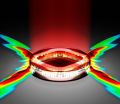(Press-News.org) Lasers – devices that deliver beams of highly organized light – are so deeply integrated into modern technology that their basic operations would seem well understood. CD players, medical diagnostics and military surveillance all depend on lasers.
Re-examining longstanding beliefs about the physics of these devices, Princeton engineers have now shown that carefully restricting the delivery of power to certain areas within a laser could boost its output by many orders of magnitude. The finding, published Oct. 26 in the journal Nature Photonics, could allow far more sensitive and energy-efficient lasers, as well as potentially more control over the frequencies and spatial pattern of light emission.
"It's as though you are using loss to your advantage," said graduate student Omer Malik, an author of the study along with Li Ge, now an assistant professor at the City University of New York, and Hakan Tureci, assistant professor of electrical engineering at Princeton. The researchers said that restricting the delivery of power causes much of the physical space within a laser to absorb rather than produce light. In exchange, however, the optimally efficient portion of the laser is freed from competition with less efficient portions and shines forth far more brightly than previous estimates had suggested.
The results, based on mathematical calculations and computer simulations, still need to be verified in experiments with actual lasers, but the researchers said it represents a new understanding of the fundamental processes that govern how lasers produce light.
"Distributing gain and loss within the material is a higher level of design – a new tool – that had not been used very systematically until now," Tureci said.
The heart of a laser is a material that emits light when energy is supplied to it. When a low level of energy is added, the light is "incoherent," essentially meaning that it contains a mix of wavelengths (or colors). As more energy is added, the material suddenly reaches a "lasing" threshold when it emits coherent light of a particular wavelength.
The entire surface of the material does not emit laser light; rather, if the material is arranged as a disc, for example, the light might come from a ring close to the edge. As even more energy is added, more patterns emerge – for example a ring closer to the center might reach the laser threshold. These patterns – called modes – begin to interact and sap energy from each other. Because of this competition, subsequent modes requiring higher energy may never reach their lasing thresholds. However, Tureci's research group found that some of these higher threshold modes were potentially far more efficient than the earlier ones if they could just be allowed to function without competition.
The researchers showed this selection could be accomplished by directing current only to the physical location where the desired mode originates. In particular, they showed how to calculate exactly how beneficial such targeting would be – and the answer was much more than expected.
Previous studies had looked at applying electric current only to the part of the laser that first reaches threshold, which succeeded in lowering the overall amount of power required to get that the laser to turn on. However, these studies did not consider the full range of modes, nor provide a way to calculate how brightness and efficiency could be controlled by targeting the delivery of current.
Instead of looking at just the first modes, Tureci's team examined dozens of possible modes and found ones that were optimally efficient. In one simulation, the most effective mode was preceded by 29 other less efficient modes that could turn on first and monopolize the pump energy. The researchers showed that applying electric current only to the pattern associated with this mode would cause it to light up first, free of competition. Targeting these higher order modes produced improvements of efficiency ranging from 100-fold to 10,000-fold, depending on the size, shape, and material of the cavity.
"We were surprised when we ran the actual numbers to see how much improvement we could get," Tureci said.
Previously, scientists designing lasers had two main ways to influence the performance: choosing the basic material that emits the light and designing the physical shape of the device – or cavity – that contains the material. The new paper now demonstrates a third approach: careful engineering of gain and loss regions within the laser.
Once a laser has been built with the fine-grained electrical connections that allow this targeting, then its performance can be controlled "on the fly," Tureci said. "Not just during fabrication."
Overall, the mathematical framework established by the researchers allows researchers to understand the full impact of one mode within the laser sapping energy from another – an effect known as "spatial hole burning." Disentangling these interactions would allow the selection of just one mode, or perhaps small number of different modes, that operate most efficiently, the researchers said.
If born out in actual lasers, the results could lead to laser devices becoming more portable. A medical diagnostic device or a bomb-detecting sensor that would have required a wall outlet, might be able to function with just batteries, Tureci said.
Tureci said the technology needed to target the delivery of power within a laser is entirely feasible for many common lasers. Just how fine the targeting needs to be depends on the wavelength of light being produced. For typical lasers described in their study, the power would need to be delivered to a space on the scale or micrometers, or thousandths of a millimeter.
INFORMATION:
Funding for the research came from the National Science Foundation through the Mid-Infrared Technologies for Health and the Environment center based at Princeton. Additional funding came from the Defense Advanced Research Projects Agency.
NEW YORK, NY (October 26, 2014)—Dietary cocoa flavanols—naturally occurring bioactives found in cocoa—reversed age-related memory decline in healthy older adults, according to a study led by Columbia University Medical Center (CUMC) scientists. The study, published today in the advance online issue of Nature Neuroscience, provides the first direct evidence that one component of age-related memory decline in humans is caused by changes in a specific region of the brain and that this form of memory decline can be improved by a dietary intervention.
As ...
MOUNT WILSON, Calif.–Astronomers at Georgia State University's Center for High Angular Resolution Astronomy (CHARA) have observed the expanding thermonuclear fireball from a nova that erupted last year in the constellation Delphinus with unprecedented clarity.
The observations produced the first images of a nova during the early fireball stage and revealed how the structure of the ejected material evolves as the gas expands and cools. It appears the expansion is more complicated than simple models previously predicted, scientists said. The results of these observations, ...
BOSTON –– Scientists say they have identified in about 20 percent of colorectal and endometrial cancers a genetic mutation that had been overlooked in recent large, comprehensive gene searches. With this discovery, the altered gene, called RNF43, now ranks as one of the most common mutations in the two cancer types.
Reporting in the October 26, 2014 edition of Nature Genetics, investigators from Dana-Farber Cancer Institute and the Broad Institute of MIT and Harvard said the mutated gene helps control an important cell-signaling pathway, Wnt, that has been ...
Why do we remember some things and not others? In a unique imaging study, two Northwestern University researchers have discovered how neurons in the brain might allow some experiences to be remembered while others are forgotten. It turns out, if you want to remember something about your environment, you better involve your dendrites.
Using a high-resolution, one-of-a-kind microscope, Daniel A. Dombeck and Mark E. J. Sheffield peered into the brain of a living animal and saw exactly what was happening in individual neurons called place cells as the animal navigated a virtual ...
Digoxin, a medication used in the treatment of heart failure, may be adaptable for the treatment of amyotrophic lateral sclerosis (ALS), a progressive, paralyzing disease, suggests new research at Washington University School of Medicine in St. Louis.
ALS, also known as Lou Gehrig's disease, destroys the nerve cells that control muscles. This leads to loss of mobility, difficulty breathing and swallowing and eventually death. Riluzole, the sole medication approved to treat the disease, has only marginal benefits in patients.
But in a new study conducted in cell cultures ...
CHAMPAIGN, Ill. — Researchers report in the journal Nature that they have made a breakthrough in understanding how a powerful antibiotic agent is made in nature. Their discovery solves a decades-old mystery, and opens up new avenues of research into thousands of similar molecules, many of which are likely to be medically useful.
The team focused on a class of compounds that includes dozens with antibiotic properties. The most famous of these is nisin, a natural product in milk that can be synthesized in the lab and is added to foods as a preservative. Nisin has ...
Most of the concerns about climate change have focused on the amount of greenhouse gases that have been released into the atmosphere.
But in a new study published in Science, a group of Rutgers researchers have found that circulation of the ocean plays an equally important role in regulating the earth's climate.
In their study, the researchers say the major cooling of Earth and continental ice build-up in the Northern Hemisphere 2.7 million years ago coincided with a shift in the circulation of the ocean – which pulls in heat and carbon dioxide in the Atlantic ...
DENVER – A better survival outcome is associated with low blood levels of squamous cell carcinoma antigen, or absence of tumor invasion either into the space between the lungs and chest wall or into blood vessels of individuals with a peripheral squamous cell carcinoma, a type of non-small cell lung cancer (NSCLC).
Lung cancer is the most common cause of cancer-related death worldwide and lung squamous cell carcinomas (SCC) account for 20-30% of all NSCLC. SCC can be classified as either central (c-SCC) or peripheral (p-SCC) depending on the primary location. While ...
VIDEO:
On Oct. 23, while North America was witnessing a partial eclipse of the sun, the Hinode spacecraft observed a 'ring of fire' or annular eclipse from its location hundreds of...
Click here for more information.
The moon passed between the Earth and the sun on Thursday, Oct. 23. While avid stargazers in North America looked up to watch the spectacle, the best vantage point was several hundred miles above the North Pole.
The Hinode spacecraft was in the right place at the ...
DURHAM, N.C. -- Many marine animals are world travelers, and scientists who study and track them can rarely predict through which nations' territorial waters their paths will lead.
In a new paper in the journal Marine Policy, Duke University Marine Lab researchers argue that coastal nations along these migratory routes do not have precedent under the law of the sea to require scientists to seek advance permission to remotely track tagged animals in territorial waters.
Requiring scientists to gain advance consent to track these animals' unpredictable movements is impossible, ...







